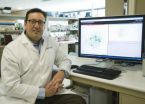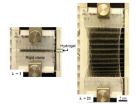(Press-News.org) SANTA CRUZ, CA--A massive international collaboration has enabled scientists to assign specific functions for 80 percent of the human genome, providing new insights into the mechanisms of gene regulation and giving biomedical researchers a solid genetic foundation for understanding how the body works in health and disease.
The results of the Encyclopedia of DNA Elements (ENCODE) project are described in a coordinated set of 30 papers published in several journals on September 5, 2012. Scientists at the University of California, Santa Cruz, have operated the Data Coordination Center for ENCODE since an initial pilot project began in 2003, and they have made all of the ENCODE data available for public use through the UCSC Genome Browser.
"Our job was to gather data from 32 labs running different types of experiments on a staggering array of cells and tissues, and we had to establish a common data language so we could get it all into a single database that scientists across the world could use. We also developed a lot of new ways of looking at the data, creating search and visualization tools so that people could find the data most relevant to them," said Jim Kent, director of the UCSC Genome Browser project and head of the ENCODE Data Coordination Center.
ENCODE is supported by the National Human Genome Research Institute (NHGRI), one of the National Institutes of Health. Hundreds of researchers across the United States, United Kingdom, Spain, Singapore, and Japan performed more than 1,600 sets of experiments on 147 types of tissue using technologies standardized across the consortium. In total, ENCODE generated more than 15 trillion bytes of raw data, and the data analysis consumed the equivalent of more than 300 years of compute time.
"We've come a long way, and we have learned an incredible amount by integrating the different types of data that ENCODE produced, which was done at a scale never before achieved in biology. This data integration was one of the keys to the success of the project," said Ewan Birney of the European Bioinformatics Institute in the United Kingdom, lead analysis coordinator of the ENCODE data.
For Kent and his data coordination team at UCSC's Center for Biomolecular Science and Engineering, the scale of the project presented many challenges. To start with, they had to coordinate a small army of researchers who were producing data in labs around the world. "We had five data wranglers who traveled around to the labs, probably four conference calls a week at the height of it, plus large group meetings twice a year, and countless emails and skype calls," Kent said.
Researchers were able to map more than 4 million regulatory regions in the human genome where proteins specifically interact with the DNA. These findings represent a significant advance in understanding the precise and complex controls over how and when genes are active within a cell.
"The regulatory elements are responsible for ensuring that you get crystalline protein in the lens of your eye and hemoglobin in your blood, and not the other way around," Kent said. "It's quite complex. The information processing and the intelligence of the genome reside in the regulatory elements. With this project, we probably went from understanding less than five percent to now around 75 percent of them."
The ENCODE data are rapidly becoming a fundamental resource for researchers working to understand human biology and disease. More than one hundred papers using ENCODE data have already been published by investigators who were not part of the ENCODE project. For example, researchers studying the genetic basis of human diseases use genome-wide association studies to identify disease-associated variants, or markers, in the genome, and they are using the ENCODE resource in an effort to determine which of the many specific variants identified in a study actually contribute to disease. These disease-associated variants map not only to protein-coding regions of the genome, but more often to the non-coding regions of the genome, the vast tracts of sequence between genes where ENCODE has identified many regulatory sites.
"As much as nine out of 10 times, disease-linked genetic variants are not in protein-coding regions," said Mike Pazin, an ENCODE program director at NHGRI. "Far from being 'junk' DNA, this regulatory DNA clearly makes important contributions to human disease."
The coordinated publication set includes one main integrative paper and five other papers in the journal Nature; 18 papers in Genome Research; and six papers in Genome Biology. The ENCODE data are so complex that the three journals have developed a pioneering way to present the information in an integrated form that they call "threads." Since the same topics were addressed in different ways in different papers, a new website will allow anyone to follow a topic through all of the papers in the ENCODE publication set in which it appears. In addition to the "threaded papers," six review articles are being published in the Journal of Biological Chemistry, and other affiliated papers in Science, Cell, and other journals.
Despite the enormity of the data set described in this historic set of publications, it does not comprehensively describe all of the functional elements in all of the different types of cells in the human body. Much additional work needs to be done, and ENCODE is about to be renewed for an additional four years. During the next phase, ENCODE will increase the depth of the catalog with respect to the types of functional elements and cell types studied. It will also develop new tools for more sophisticated analyses of the data.
### END
UC Santa Cruz provides access to encyclopedia of the human genome
UCSC Genome Browser is a gateway for scientists worldwide to explore a new encyclopedia of the functional elements encoded in the human genome
2012-09-06
ELSE PRESS RELEASES FROM THIS DATE:
Most English football teams don't follow international guidelines on concussion
2012-09-06
Most professional English football teams don't comply with international guidelines on concussion among players, which ensure they are safe to return to play, indicates research published online in the British Journal of Sports Medicine.
The Consensus in Sport (CIS) guidelines were developed following the first international conference on concussion in sport in 2001.
This was convened by the International Ice Hockey Federation, FIFA (Federation Internationale de Football Association), and the International Olympic Committee Medical Commission in recognition of the inevitability ...
Tests for silent neck artery narrowing to curb stroke risk: Waste of resources
2012-09-06
Tests to screen for "silent" neck artery narrowing in a bid to curb the risk of a stroke result in many unnecessary and costly surgical procedures, and ultimately save very few lives, concludes an editorial in the Journal of NeuroInterventional Surgery.
In 2-6% of European men aged 60 plus, the major arteries supplying the brain (carotid arteries) are narrowed by 50-99%. This condition, termed carotid stenosis or atherosclerosis, accounts for 10-15% of strokes (data not in paper).
Carotid atherosclerosis is commonest in those with mild peripheral arterial disease in ...
In massive genome analysis ENCODE data suggests 'gene' redefinition
2012-09-06
Cold Spring Harbor, N.Y. – Most people understand genes to be specific segments of DNA that determine traits or diseases that are inherited. Textbooks suggest that genes are copied ("transcribed") into RNA molecules, which are then used as templates for making protein – the highly diverse set of molecules that act as building blocks and engines of our cells. The truth, it now appears, is not so simple.
As part of a huge collaborative effort called ENCODE (Encyclopedia of DNA Elements), a research team led by Cold Spring Harbor Laboratory (CSHL) Professor Thomas Gingeras, ...
Millions of DNA switches that power human genome's operating system are discovered
2012-09-06
The locations of millions of DNA 'switches' that dictate how, when, and where in the body different genes turn on and off have been identified by a research team led by the University of Washington in Seattle. Genes make up only 2 percent of the human genome and were easy to spot, but the on/off switches controlling those genes were encrypted within the remaining 98 percent of the genome.
Without these switches, called regulatory DNA, genes are inert. Researchers around the world have been focused on identifying regulatory DNA to understand how the genome works. ...
Call for a new approach to fighting tuberculosis
2012-09-06
Boston, MA – Each year, nearly 2 million people die from tuberculosis – a treatable disease that has been brought under control in the United States, but continues to ravage other parts of the world. This health inequity should prompt a complete rethinking of the way tuberculosis is fought on a global level, argue Salmaan Keshavjee, MD, PhD, and Paul Farmer, MD, PhD, from Brigham and Women's Hospital (BWH). Their argument appears in an essay published September 6 in the New England Journal of Medicine.
"The global approach to fighting tuberculosis has been lacking," ...
Comprehensive transcriptome analysis of human ENCODE cells
2012-09-06
ENCODE, an international research project led by the National Human Genome Research Institute (NHGRI), has produced and analyzed 1649 data sets designed to annotate functional elements of the entire human genome. Data on transcription starting sites (TSS) contributed by a research team at the RIKEN Omics Science Center provided key anchor points linking the epigenetic status of genes observed at the 5' end directly to their RNA output.
The ENCODE (Encyclopedia of DNA Elements) project aims to delineate all functional elements encoded in the human genome. Thirty-two institutes ...
Quantum physics at a distance
2012-09-06
This press release is available in German.
Physicists at the University of Vienna and the Austrian Academy of Sciences have achieved quantum teleportation over a record distance of 143 km. The experiment is a major step towards satellite-based quantum communication. The results have now been published in "Nature" (Advance Online Publication/AOP).
An international team led by the Austrian physicist Anton Zeilinger has successfully transmitted quantum states between the two Canary Islands of La Palma and Tenerife, over a distance of 143 km. The previous record, set ...
Tough gel stretches to 21 times its length, recoils, and heals itself
2012-09-06
Cambridge, Mass. - September 5, 2012 - A team of experts in mechanics, materials science, and tissue engineering at Harvard have created an extremely stretchy and tough gel that may pave the way to replacing damaged cartilage in human joints.
Called a hydrogel, because its main ingredient is water, the new material is a hybrid of two weak gels that combine to create something much stronger. Not only can this new gel stretch to 21 times its original length, but it is also exceptionally tough, self-healing, and biocompatible—a valuable collection of attributes that opens ...
The ENCODE Project publishes new genomic insights in special issue of Genome Research
2012-09-06
Genome Research publishes online and in print today a special issue dedicated to The ENCODE (ENCyclopedia Of DNA Elements) Project, whose goal is to characterize all functional elements in the human genome. Since the completion of the pilot phase of the project in 2007, covering 1% of the genome, The ENCODE Consortium has fanned out across the genome to study function and regulation on an unprecedented scale. This special issue presents novel findings, methodologies, and resources from ENCODE that bring extensive insight to gene regulation and set the stage for future ...
BUSM/VA researchers examine new PTSD diagnosis criteria
2012-09-06
(Boston) – Results of a study led by researchers at Boston University School of Medicine (BUSM) and the Veterans Affairs (VA) Boston Healthcare System indicate that the proposed changes to the diagnosis of post-traumatic stress disorder (PTSD) will not substantially affect the number of people who meet criteria for the disorder.
Mark W. Miller, PhD, associate professor at BUSM and a clinical research psychologist at the National Center for PTSD at VA Boston Healthcare System served as lead author of the study, which is published online in Psychological Trauma: Theory, ...
LAST 30 PRESS RELEASES:
Beech trees use seasonal soil moisture to optimize water uptake
How thinning benefits growth for all trees
Researchers upgrades 3-PG forest model for improved accuracy
Achieving anti-thermal-quenching in Tb3+-doped glass scintillators via dual-channel thermally enhanced energy transfer
Liquid metal modified hexagonal boron nitride flakes for efficient electromagnetic wave absorption and thermal management
Failure mechanisms in PEM water electrolyzers
Study captures how cancer cells hide from brain immune cells, shows that removing their “don’t eat me” signals stops their escape
New breakthrough in detecting ‘ghost particles’ from the Sun
Half of people arrested in London may have undiagnosed ADHD, study finds
From dots to lines: new database catalogs human gene types using ’ACTG’ rules
Persistent antibiotic resistance of cholera-causing bacteria in Africa revealed from a multinational workshop for strengthening disease surveillance
SwRI, Trinity University to synthesize novel compound to mitigate effects of stroke, heart attack
Novel endocrine therapy giredestrant improves disease-free survival over standard of care for patients with early-stage breast cancer in phase III lidERA trial
Gen Z views world as "scary place" with growing cynicism about ability to create change
Biosensor performance doubled – New applications possible
Leveraging incomplete remote sensing for forest inventory
Key chemical in dark chocolate may slow down ageing
New 15-minute hepatitis C test paves the way for same-day treatment
Uranus and Neptune might be rock giants
Magnetically actuated soft electrodes for multisite bioelectrical monitoring of ex vivo tissues
FAU engineers decode dementia type using AI and EEG brainwave analysis
Carrier-free peptide–daunorubicin–small interfering RNA nanoassembly for targeted therapy of acute myeloid leukemia
Global Virus Network announces appointment of new board members
Artificial beaver dams show promise in offsetting climate change effects
Could hidden infections be fueling long COVID?
Targeted oxygen for initial resuscitation of preterm infants
Researchers develop models to help diagnose ALS earlier through blood biomarkers
Jeonbuk National University researchers develop novel eco-friendly and photo-switchable smart adhesives
Magnetic ordering induces Jahn–Teller effect in spinel-type compounds
A mitochondrial protein may hold the secret to longevity, new study finds
[Press-News.org] UC Santa Cruz provides access to encyclopedia of the human genomeUCSC Genome Browser is a gateway for scientists worldwide to explore a new encyclopedia of the functional elements encoded in the human genome


